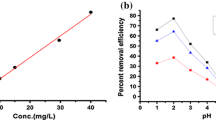Abstract
The biological treatment of triphenylmethane dyes is an important issue. Most microbes have limited practical application because they cannot completely detoxicate these dyes. In this study, the extractive biodecolorization of triphenylmethane dyes by Aeromonas hydrophila DN322p was carried out by introducing the cloud point system. The cloud point system is composed of a mixture of nonionic surfactants (20 g/L) Brij 30 and Tergitol TMN-3 in equal proportions. After the decolorization of crystal violet, a higher wet cell weight was obtained in the cloud point system than that of the control system. Based on the results of thin-layer chromatography, the residual crystal violet and its decolorized product, leuco crystal violet, preferred to partition into the coacervate phase. Therefore, the detoxification of the dilute phase was achieved, which indicated that the dilute phase could be discharged without causing dye pollution. The extractive biodecolorization of three other triphenylmethane dyes was also examined in this system. The decolorization of malachite green and brilliant green was similar to that of crystal violet. Only ethyl violet achieved a poor decolorization rate because DN322p decolorized it via adsorption but did not convert it into its leuco form. This study provides potential application of biological treatment in triphenylmethane dye wastewater.





Similar content being viewed by others
References
Au W, Pathak S, Collie CJ, Hsu TC (1978) Cytogenetic toxicity of gentian violet and crystal violet on mammalian cells in vitro. Mutat Res-Gen Tox En 58(2–3):269–276
Chen C-C, Liao H-J, Cheng C-Y, Yen C-Y, Chung Y-C (2007) Biodegradation of crystal violet by Pseudomonas putida. Biotechnol Lett 29(3):391–396
Chen CH, Chang CF, Liu SM (2010) Partial degradation mechanisms of malachite green and methyl violet B by Shewanella decolorationis NTOU1 under anaerobic conditions. J Hazard Mater 177(1–3):281–289
Forgacs E, Cserhati T, Oros G (2004) Removal of synthetic dyes from wastewaters: a review. Environ Int 30(7):953–971
Gregory P (1993) Encyclopedia of chemical technology. In: Kroschwitz JI (ed) Dyes and dye intermediates, vol 8. Wiley, New York, pp 544–545
Jang MS, Lee YM, Kim CH, Lee JH, Kang DW, Kim SJ, Lee YC (2005) Triphenylmethane reductase from Citrobacter sp. strain KCTC 18061P: purification, characterization, gene cloning, and overexpression of a functional protein in Escherichia coli. Appl Environ Microbiol 71(12):7955–7960
Kim MH, Kim Y, Park HJ, Lee JS, Kwak SN, Jung WH, Lee SG, Kim D, Lee YC, Oh TK (2008) Structural insight into bioremediation of Triphenylmethane dyes by Citrobacter sp. triphenylmethane reductase. J Biol Chem 283(46):31981–31990
Pan T, Ren S, Guo J, Xu M, Sun G (2012) Biosorption and biotransformation of crystal violet by Aeromonas hydrophila DN322p. Front Environ Sci Eng. doi:10.1007/s11783-012-0435-6
Pan T, Wang Z, Xu J-H, Wu Z, Qi H (2010) Extractive fermentation in cloud point system for lipase production by Serratia marcescens ECU1010. Appl Microbiol Biotechnol 85(6):1789–1796
Srivastava S, Sinha R, Roy D (2004) Toxicological effects of malachite green. Aquat Toxicol 66(3):319–329
Wang Z, Xu J-H, Chen D (2008) Whole cell microbial transformation in cloud point system. J Ind Microbiol Biotechnol 35(7):645–656
Wu J, Jung B-G, Kim K-S, Lee Y-C, Sung N-C (2009) Isolation and characterization of Pseudomonas otitidis WL-13 and its capacity to decolorize triphenylmethane dyes. J Environ Sci 21(7):960–964
Xue Y, Qian C, Wang Z, Xu J-H, Yang R, Qi H (2009) Investigation of extractive microbial transformation in nonionic surfactant micelle aqueous solution using response surface methodology. Appl Microbiol Biotechnol 85(3):517–524
Yatome C, Yamada S, Ogawa T, Matsui M (1993) Degradation of crystal violet by Nocardia corallina. Appl Microbiol Biotechnol 38(4):565–569
Acknowledgments
We acknowledge the National Basic Research Program of China (973 Program) (2012CB22307), the Team Project of the Natural Science Foundation of Guangdong Province (9351007002000001), the Natural Science Foundation of Guangdong Province (S2011010004267; 9251007002000003), the Outstanding Scholarship Foundation of Guangdong Academy of Sciences (200902), the Guangdong–Hongkong Technology Cooperation Funding (2009A030902003), Guangdong Province–Chinese Academy of Sciences strategic cooperative project (2009B091300023, 2010B090301048), and the International Cooperation Projects of Guangdong Province (2011B050400005).
Author information
Authors and Affiliations
Corresponding author
Rights and permissions
About this article
Cite this article
Pan, T., Ren, S., Xu, M. et al. Extractive biodecolorization of triphenylmethane dyes in cloud point system by Aeromonas hydrophila DN322p. Appl Microbiol Biotechnol 97, 6051–6055 (2013). https://doi.org/10.1007/s00253-012-4422-4
Received:
Revised:
Accepted:
Published:
Issue Date:
DOI: https://doi.org/10.1007/s00253-012-4422-4




